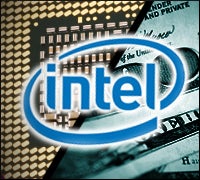 |
SANTA CLARA, Calif. — There may be a recession in the economy, but “there is no recession in the growth of the Internet,” declared Intel (NASDAQ: INTC) CEO Paul Otellini at an investors meeting here at his company’s headquarters.
The Internet is growing at a compound annual growth rate (CAGR) of 46 percent, he said, and in 2009, it will grow more than it had in total capacity in 2006.
“If you go back to the dot-com bubble busting in 2000-2001, there was no drop in Internet traffic at that time,” Otellini told the audience. “It continues to grow.”
Something has to power all the computers running and connecting to that network. Guess who Intel has in mind? Certainly not AMD (NYSE: AMD).
Intel is also targeting a number of adjacent industries: low-cost PCs and netbooks, handhelds/smartphones, embedded devices and consumer electronics. Otellini estimated each to be worth about $10 billion per year for Intel.
Netbooks “will bring the next billion people in the world into computing in a low-cost fashion,” he said. Otellini added that smartphones meanwhile could reach 250 million units by 2011, resulting in a $10 billion silicon business as they require increasing amounts of processing power and memory.
Not every segment will see those sorts of growth, however. Portions of the market for embedded systems
Likewise, the consumer electronics market continues to grow in computing and complexity, but it is dominated by slow-moving, entrenched players. Cracking that market would take the longest, he said.
The server business also represents a sizable market for Intel, with high performance computing (HPC) accounting for 25 percent of Intel’s total server business sales, and 50 percent of mission critical systems are running Itanium. Also, cloud buildout from 2009 to 2012 is growing at a CAGR of 21 percent, and Intel sees itself getting a piece of that.
The company is also expecting a big jump in sales for hardware replacements. More than 12 million servers in deployment today are four years old or older, so server replacement sales are expected to begin soon, and Intel will take advantage of that market.
On the desktop, Intel said there are 800 million desktops in the world and 45 percent of them are more than three years old, making them ripe for upgrading.
Segmenting products is increasingly important for the company, enabling it to become more competitive in new product segments, it said. For example, as it designs system-on-a-chip derivatives with lower system price points, the cost to make derivatives goes down and it’s easier to move into new markets.
Road to recovery
After the horrible Christmas quarter last year, Intel turned things around slightly with the Q1 numbers. At that time, Otellini mentioned on the conference call with analysts that the industry had bottomed out and he expected a more seasonal year, albeit at a lower base rate of sales.
So far, things are on track for recovery, he reported. “Order patterns are a little better than expected. Q2 is always very dependent on June but with that said, so far so good,” said Otellini. “Our view of the year is that we will see seasonality in the second half.”
[cob:Special_Report]Otellini struck a similarly cautions tone following his presentation, when asked if he thought sales might get a boost from Microsoft’s (NASDAQ: MSFT) plans to release Windows 7 this fall.
“I hope so,” Otellini told InternetNews.com. “From what I’ve seen, Windows 7 looks pretty good, but it’s all up to business spending.”
Some specific trouble areas also seem to be seeing improvement from a year ago. During last year’s shareholder meeting, Otellini addressed problems with the firm’s flash memory business, promising it would not hurt Intel’s overall profit.
Today, Otellini would only say that the flash business is “not a drag on the P&L any more,” or he would have addressed it at the meeting. Intel doesn’t break out individual product businesses, however.
Otellini also detailed some of the effects of Intel’s ongoing restructuring, which has enabled the company to save a considerable amount of money, he said.
Intel has gone from 103,000 employees in mid-2006 to 78,000 by the end of this year. The result has been a huge savings in operating expensive. All told, more than $4 billion has been banked: $2.5 billion in 2007, $850 million this year and $700 million next year.
Update adds additional comments from Otellini.


